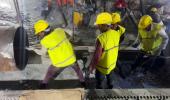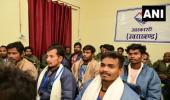'These are people whom very few give importance and they were doing a mammoth job for the nation.'

"The rat-miners did a tremendous job. They worked inside the enclosed space cutting metal parts with oxyacetylene torches. It is a very difficult task because of the heat, gases and lack of oxygen," says Lieutenant General Syed Ata Hasnain, retired, member of the National Disaster Management Authority.
The general explained the multi-dimensional approach of the rescue and how resources were moved from different parts of the country by air, rail and road.
"It was a monumental national effort. I knew that there was just too much talent involved in the rescue. I was sure we will achieve it," General Hasnain tells Rediff.com's Archana Masih in a phone conversation after the completion of a rescue operation that India has never seen before.
This rescue was akin to planning a war campaign; like going into battle, isn't it? What were some of the key aspects of this mammoth operation?
This is a question that many are asking because people want to know the planning and action that brought the 41 men home.
It began on November 12 with the prime minister and the prime minister's office.
The first call went out to the railway ministry and the railway board because of their reputation in large infrastructure construction, including tunnelling.
It was soon evident that the rescue needed a multi-dimensional effort. We started exploring different options and gathering resources.
We were ready for the long haul.
The PMO drove this effort all along with the Cabinet secretariat, the ministries of home, road transport and highways and health. The National Disaster Management Authority, the state government, the NDRF (National Disaster Response Force), the Indian Army, Indian Air Force, the State Disaster Response Force of Uttarakhand, etc.
These are just some of the agencies among the plethora of organisations that worked towards on the rescue.
When did you know that this this rescue would be a long haul?
By November 16-17 it was quite clear that this would be a long haul.
The American Auger machine brought in for boring did a good job. A lot of people are wondering why it was unable to complete the work, but we must understand that it was up against mammoth challenges.
It cut through almost 47 metres of very hard debris which consisted of concrete, iron rods, steel webbing and different kinds of material that had fallen down.
This exercise took a toll on the boring component of the Auger machine which finally broke and got stuck inside the tunnel.
It took a monumental effort to cut that material and pull it out. It required specialised equipment that was flown in from places as far as Rajahmundry near Hyderabad by the Indian Air Force, IndiGo airlines. It was then transported by road up to the tunnel.
We tried horizontal boring and also vertical drilling.
The Border Roads Organisation constructed a road so that the machine could be taken up there for vertical drilling.
Vertical drilling went in as deep as 46 metres, but we decided to stop it because we didn't want the horizontal drilling effort to get disturbed.
I am explaining this to depict the simultaneous decisions that were being taken and how resources from different parts of the country were moved by air, rail and road.
Green corridors were created for quick movement of resources by the railway board, Uttarakhand government and several other state governments to allow unimpeded movement across the vast country.
Officials were spoken to at three o'clock in the morning. Deputy commissioners, SSPs, district magistrates, SPs etc remained awake and were willing to take risks to ensure that this movement takes place.

When you were giving the press conference on Tuesday evening, the rescue was close and yet so far. I could sense the cautiousness in your voice.
The last two metres were crucial. I did not want to announce prematurely until the Government of India was informed about it.
It was important to be cautious because if you generate hope and are met with failure, the disappointment of 1.4 billion would be monumental.
One wrong message could have disappointed the nation. We knew we would succeed, but we had to be cautious because we could have encountered obstacles in the last two metres.
A premature announcement would not have been the right thing to do.
The twelve rat miners worked brilliantly to achieve the last 10-12 metres.
What they did was tremendous. They have the ability to work in enclosed space. They can stay in there for hours and continue cutting metal parts with oxyacetylene torches etc. It is a very difficult task because of the heat, ensuing gases, lack of oxygen, etc.
Some of them were speaking on television before going in, they sounded so confident and self-assured. It was very reassuring for the country. These are people whom very few give importance and they were doing a mammoth job for the nation.
The rat miners were brought in after the Auger machine had completed clearing up to 47 meters. They completed the remaining 10 to 12 metres and were joined by Army engineers and others.

I hope the government will recognise them adequately.
The government will surely recognise them in due course. There is a system in government which recognises individuals who put their lives in danger in this manner.
What was the role of international experts in this operation?
As soon as the enormity of this challenge was realised -- which happened within the first 24 hours itself -- we initially reached out to international talent online.
Many people were consulted, including those who conducted the rescue in Thailand.
We have experts in our own country, but we also wanted to consult those who had experience of such rescue efforts.
A very wise decision was taken to fly in foreign experts. At times there were no direct or appropriate flights. Some like Professor Arnold Dix came on their own, by rerouting themselves from different directions to land in Delhi.
They were four foreign experts. They camped at the site and their presence has been very reassuring.
We were disappointed when the Auger machine broke down, but they kept pushing our hopes up. They said it would take time, but all 41 will definitely come back alive.
Professor Dix was guiding us throughout. There were our own experts and engineers from different government departments and organisation, but his voice carried weight because of his experience.

What was the most difficult moment of these entire 17 days?
The breaking down of the Auger machine.
The broken parts had to be pulled out of the tunnel in order to start the manual boring. The equipment required to achieve this included magna cutters, plasma and laser cutters, etc that had to be flown from different parts of the country. We had to wait till that was brought in and then pull out the last bits of the auger.
The manual mining began thereafter. The rat-miners achieved the last 10-12 metres very quickly. I was expecting that they would probably take 48 to 72 hours. but they were very, very good.

At any point, did you ever think what if this doesn't succeed?
Maybe somewhere in the back of the mind, but I knew that there was just too much talent involved in the rescue. I was sure we will achieve it.
It also speaks about the resilience and courage of the 41 workers.
Their survival skills were of very high order. They are hardy people who have been working in the mountains although they are from the plains. They are main workforce of companies involved in infrastructure development in the mountains.
I can vouch that the Border Roads Organisation swears by them.
These men had the capacity, resilience and courage to survive.

The state government has announced Rs 1 lakh each for the workers; do you think there'll be more compensation for them? Also, will there accountability sought from those constructing the tunnel?
The goal of the NDMA was to rescue the trapped men. There will be many issues which will come up for discussion and the reasons for the tunnel collapse will be analysed.
But that is for subsequent times. This is a happy moment for all of us and we should take heart from it just now.
Feature Presentation: Aslam Hunani/Rediff.com










